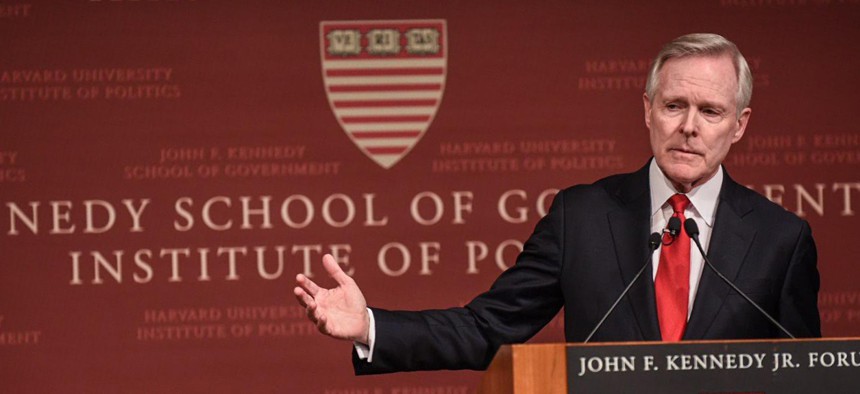
Secretary of the Navy Ray Mabus speaks at Harvard University, April 13, 2016. Navy photo
Harvard’s Love-Hate Relationship with the US Military
The gap between America’s elite educational institutions and its military remains wide. Harvard faces a moral imperative to help close it.
Of late, Harvard University has been attempting to redefine its relationship with the nation’s military. Today, the campus welcomed Navy Secretary Ray Mabus, who came to commemorate five years since the university lifted its ROTC ban. He was joined at the Kennedy School of Government by Harvard President Drew Faust, who helped lift the ban as part of an effort to end a standoff between Harvard and the military that dates back to the Vietnam War. Last month, Faust gave a stirring lecture at the U.S. Military Academy. Urging cadets “to be speakers of words and doers of deeds,” Faust said, “I wish there were more of you.”
Although Secretary Mabus’ visit and Faust’s address reflect thawing relations, they obscure an important and uncomfortable truth: in an undergraduate student body of about 6,700, there are only 23 ROTC cadets and fewer than five veterans. Neither of these figures has increased materially since the university ended the ROTC ban. Neither is expected to increase in coming years. In fact, with a (relatively) large graduating class, the number of cadets may even decrease. By comparison, Yale’s Navy ROTC program, reinstituted one year after Harvard’s, is now the gold standard for the Ivy League, with more than 40 midshipmen and women.
Last year, on Memorial Day, a group of Harvard students released a comprehensive review of the university’s efforts to integrate current and former members of the military. Overall, the findings were mixed: although several graduate schools—Harvard Business School, Harvard Kennedy School, and Harvard Law School—have sizeable numbers of active military and veteran students, the undergraduate Harvard College lags seriously behind.
The primary obstacle to growing the size of the university’s ROTC program appears to be structural barriers that did not disappear when the ban was lifted. Cadets and midshipmen must commute across town to the Massachusetts Institute of Technology, where units are headquartered, in order to attend classes for which they, for the most part, receive no credit. Moreover, the Harvard College Office of Admissions and Financial Aid makes no active effort to attract veterans and potential cadets. Of greatest concern, there appears to be no veteran representation within the university’s senior leadership.
The reality is that the gap between America’s elite educational institutions and its military remains wide. Harvard faces a moral imperative to close it by welcoming more ROTC cadets and veterans to campus. Inclusivity—that is, making reasonable efforts to extend access to elite undergraduate education to all those who might qualify, including deserving veterans—is a worthy goal in its own right, one that is well aligned with Harvard’s core values.
That few veterans apply to Harvard — a line that I myself have heard from College admissions officers — is a poor excuse for the university’s inaction. Harvard offers no similar explanation, for instance, when it comes to low-income students, or those from ethnic or racial minorities. In fact, the university works arduously to attract and embrace these populations—to its great credit. It is both ironic and telling that an institution whose faculty seem so preoccupied with shoring up inequality would ignore the circumstance that veterans, by the numbers at least, very clearly do not enjoy equal access to elite undergraduate education.
Importantly, the consequences of a persistent divide stretch well beyond the bounds of morality. Indeed, there is a strong practical argument for educating more future military leaders at Harvard. In every hotspot across the world, the U.S. faces a veritable mosaic of insurgencies, terrorist groups, and ethnic and tribal factions. Meanwhile, other global powers, old and new, also present significant challenges. Who better to help navigate such complexity than America’s “best and brightest”—those educated at places like Harvard?
The present situation at Harvard College contrasts starkly with the university’s history. Except for West Point and the Naval Academy, Harvard has more Medal of Honor recipients than any other educational institution in the United States. George Washington took command of the Continental Army on Cambridge Commons and used the College to quarter his troops. During World War II, large swathes of Harvard’s campus were dedicated to Army and Naval officer training. More than 40 memorials across campus provide evidence of a university that used to enjoy a very close relationship with the military.
Even so, Secretary Mabus’ visit to Harvard unintentionally underscores great hypocrisy in Cambridge. I am grateful to President Faust for welcoming back ROTC. I am equally grateful for her service to Harvard. Thus far, however, the university seems oddly, and indolently, content with mere symbolism. Over the past few years, I have often exhorted frustrated colleagues to “be patient” with Harvard. As I prepare to graduate, having observed little in the way of real change, I can no longer provide such counsel in good conscience. Faust’s address extolled the virtues of being “a speaker of words, and a doer of deeds.” Let’s hope that one day Harvard follows its own advice.